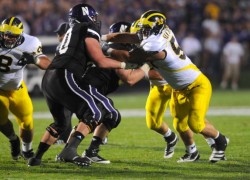
One spot in the Michigan Football Museum in Schembechler Hall has remained empty for the past three years. In the trophy case for rivalry games, one prize is missing. Instead, a placard reads: “The Paul Bunyan Trophy is temporarily located in East Lansing but will return next year.”
Having made sure his countdown clocks were synced with the 12:01 kickoff time, Michigan coach Brady Hoke gathered his players Sunday to discuss the history of the Michigan and Michigan State rivalry.
It’s the battle for the state and a battle for bragging rights, he told the team. A win gives Michigan alums the edge for an entire year. Win it for them, he said.
He also told his players that he won’t have to do much motivating, the seniors and leaders understand what the rivalry means.
They’re fighting for the Paul Bunyan Trophy — also known as the Governor’s Trophy — and the trophy is won or lost on the ground.
In 38 of the past 41 games, the team that ran for more yards won the game.
“It was always going to be a dogfight,” Hoke said.
“It always was (the most physical game). … They were going to pound you off the football. You had to match that intensity. They’re going to punch you in the mouth and you better punch back.”
This year’s version of the epic is no different.
Michigan boasts the No. 7 rushing offense in the country, led by its star quarterback Denard Robinson, who already has 720 yards in six games. But the junior Robinson was having similar success on the ground a year ago in his breakout season, and the physical Spartans dragged Robinson down from his high.
He threw three interceptions — the most he would toss all season — and was held to four yards per carry in a demoralizing blowout loss.
“They just out-physicaled us (last year),” said senior tight end Kevin Koger. “They just play into you well. … If we don’t push them back, we’re not going to control the line of scrimmage. (Then) we’re not going to win.
“They had a great plan against (Robinson). They really contained him to the pocket, didn’t let him get outside. And they were pushing our linemen back and (our) tight ends. So he really couldn’t get out. It’s hard to get out when you have players in your lap or guys around your legs.”
Since then, not much has changed. Robinson still needs space. The Spartans are still physical.
This season, Michigan State has allowed just 64 rushing yards per game and two touchdowns on the ground, good enough for the third-best rush defense in the nation. The man in the middle is one to watch. Junior defensive end Jerel Worthy, perhaps one of the best linemen in the conference, posted three tackles, a sack and a blocked field goal against Michigan last season.
“As a player I think he’s physical, a very good athlete,” Hoke said of Worthy. “He’s got a great sense in timing from a fundamental side on movements and those things, and he plays with a great leverage.”
Worthy’s perfect for disrupting any comfort Robinson has in the pocket or running the ball.
Adding to Hoke’s worries is the fact that Worthy and the rest of the Spartans’ front four is coached by Hoke’s friend, Ted Gill, the man who coached defensive linemen while Hoke played at Ball State. So Hoke knows they’ll play sound football.
Hoke will have enough to worry about with his own defensive line. All fall camp, the coaches used the defense’s poor history and poor reputation as motivation.
Trying to emphasize taking pride in sound rush defense, the coaches would mention how many yards were allowed in some of Michigan’s poorer performances.
“Michigan State’s one of the teams that comes up because we gave up so much yards rushing to them,” said fifth-year senior Ryan Van Bergen. “They’re going to rush the football. That’s what they want to do. That’s what they are. They run the football and take shots downfield. So it’s going to fall in our lap as far as the front seven making sure we can take control of the game and shut down their rushing attack.
“When it comes to rushing, it’s all about up front — who’s more physical up front. It’s always been about who’s going to hit who harder and who’s going to move guys off the ball.”
“Physical” might just be Hoke’s middle name.
His team has played with that mentality since he stepped foot on campus, and two of the strengths of the 11th-ranked Wolverines have been the play of their experienced offensive and defensive lines.
Leading with their two lines, Michigan’s 6-0 start is different from past year’s fast starts potentially because of Hoke and the new coaching staff. But each of the past three losses against Michigan State began a downslide.
“It’s definitely the turning point in our season,” Koger said. “If you’ve seen, the last couple of years, it really makes or breaks our season.”
Hoke can take solace in that this one is clearly in the hands of his linemen — at least it has been 38 of the last 41 times.
